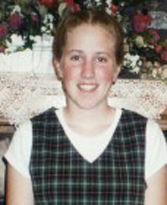



|
The Celebrity Interview
Five students from Grand Island, Nebraska, tell us about a new way to do a biography report: the Celebrity Interview. By Alicia M. Bartol SCR*TEC |
|
According to Malinda, the assignment was to: "pick a celebrity . . . and to think of questions you would ask them if you had a chance to interview them face to face. Then you'd have your questions checked by Miss Van Winkle, and then go on the Internet and try to find answers to them." |
 Megan really enjoyed doing the Celebrity Interview. She said, "I loved it! It was fun." |
Malinda added, "You'd put the answers in your own words, so it really sounded like the celebrity was answering you." Malinda and Megan both researched female athletes. Malinda "interviewed" tennis star Monica Seles, and Megan interviewed gymnast Dominique Moceanu, the United States' youngest Olympic gold medal winner. Miss Van Winkle encouraged the students to consider their choice of celebrity carefully. The celebrity should ideally be a role model. Andrea explained, "She wouldn't let us do [just] anybody, like Beavus and Butthead. Our parents would have to approve of it, and she would also." Andrea chose Lisa Leslie, gold medal Olympian and current leading scorer for the WNBA's LA Sparks. |
| Creating a successful celebrity interview required the students to hone their researching skills, both in the library and on the Internet. Most of the students had never used the Internet before. Cody said, "I thought it was gonna be hard; I really didn't know much about the computer or anything." |
 Andrea, who had never used the Internet before, researched basketball star Lisa Leslie. |
Megan was also fairly new to the Internet. She said, "At first, I kind of got confused, and I was a little lost on what to look up to find certain answers, but I figured it out pretty quickly." One of the most important lessons she learned was how to recognize legitimate sites that could be used for her research. She said, "A lot of times, you can tell by what the site is, if it's by some person, or if it's by maybe a magazine or more of a business-type sounding [site]. And you can look at the answers, and if they don't match up with other answers you've found, then you know that probably some of the other stuff is not going to be true." |
| |
 Ross liked working on the computers and learning how to use the Internet. |
|
| Malinda had similar praise. The thing she enjoyed most about the project was answering her own questions. She said, "It was a lot different [from other projects]. It was a lot more fun. I don't know what made it different; it was just something that you're really interested in. [The teacher] didn't give you a certain person and say, 'Look . . . write a paper on them.' It was more of [having] to use your imagination." |
 Cody chose to research Nebraska coach Tom Osborne. The thing he most enjoyed about the project was searching on the Internet. |
Megan said, "I liked it 'cause it was fun just getting on the Internet and being able to search and be independent and not having them tell you specific sites to go to. You got to choose what areas you wanted to explore and find out about that person." Despite the scope of the project, which often had students working in computer labs during their free time, every student finished their interviews on time. Malinda said, "It went really fast. [Miss Van Winkle] made sure that our time was used wisely. You had dates to make sure you were done by this time so you couldn't put it off." |
|
 Malinda enjoyed learning about Monica Seles, who beat the odds and rose to the top of the tennis ranks after a stabbing in Hamburg in 1993. |
To read Miss Van Winkle's story and see handouts for the Celebrity Interview Project, visit this month's Teacher Testimony. |
|